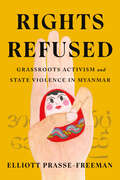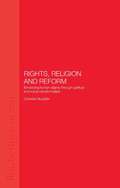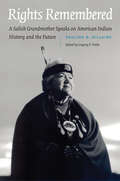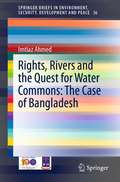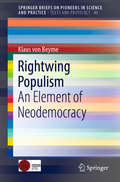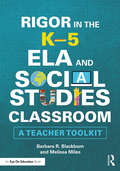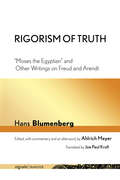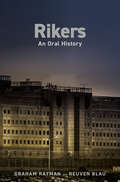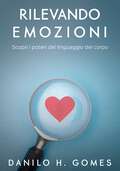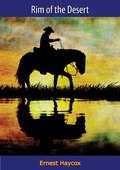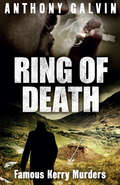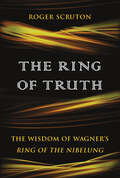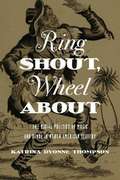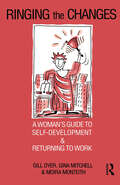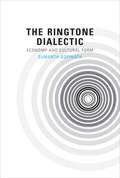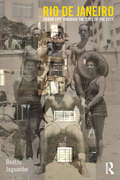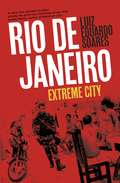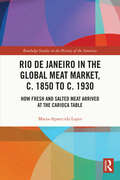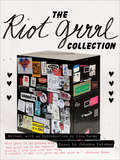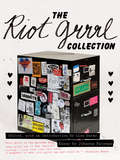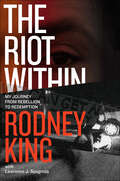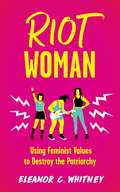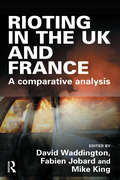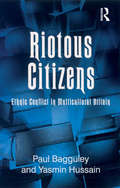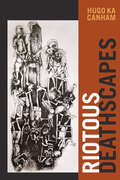- Table View
- List View
Rights Refused: Grassroots Activism and State Violence in Myanmar (Stanford Studies in Human Rights)
by Elliott Prasse-FreemanFor decades, the outside world mostly knew Myanmar as the site of a valiant human rights struggle against an oppressive military regime, predominantly through the figure of Nobel Peace Prize winner Aung San Suu Kyi. And yet, a closer look at Burmese grassroots sentiments reveals a significant schism between elite human rights cosmopolitans and subaltern Burmese subjects maneuvering under brutal and negligent governance. While elites have endorsed human rights logics, subalterns are ambivalent, often going so far as to refuse rights themselves, seeing in them no more than empty promises. Such alternative perspectives became apparent during Burma's much-lauded decade-long "transition" from military rule that began in 2011, a period of massive change that saw an explosion of political and social activism. How then do people conduct politics when they lack the legally and symbolically stabilizing force of "rights" to guarantee their incursions against injustice? In this book, Elliott Prasse-Freeman documents grassroots political activists who advocate for workers and peasants across Burma, covering not only the so-called "democratic transition" from 2011-2021, but also the February 2021 military coup that ended that experiment and the ongoing mass uprising against it. Taking the reader from protest camps, to flop houses, to prisons, and presenting practices as varied as courtroom immolation, occult cursing ceremonies, and land reoccupations, Rights Refused shows how Burmese subaltern politics compel us to reconsider how rights frameworks operate everywhere.
Rights, Religion and Reform: Enhancing Human Dignity through Spiritual and Moral Transformation
by Chandra MuzaffarThis book discusses issues concerning human rights and religion. Is a more integrated approach to human rights desirable - an approach that transcends the individual-centred orientation of civil and political liberties of the dominant centres of power in the West? How can religious thought contribute to an integrated notion of human rights and human dignity? What sort of transformation should religion itself undergo in order to enable it to come to grips with contemporary challenges? Related to this is a larger question: How can universal spiritual and moral values help to shape politics, the economy and society as a whole?
Rights Remembered: A Salish Grandmother Speaks on American Indian History and the Future (American Indian Lives)
by Pauline R. Hillaire Gregory P. FieldsRights Remembered is a remarkable historical narrative and autobiography written by esteemed Lummi elder and culture bearer Pauline R. Hillaire, Scälla–Of the Killer Whale. A direct descendant of the immediate postcontact generation of Coast Salish in Washington State, Hillaire combines in her narrative life experiences, Lummi oral traditions preserved and passed on to her, and the written record of relationships between the United States and the indigenous peoples of the Northwest Coast to tell the story of settlers, government officials, treaties, reservations, and the colonial relationship between Coast Salish and the white newcomers. Hillaire’s autobiography, although written out of frustration with the status of Native peoples in America, is not an expression of anger but rather represents, in her own words, her hope “for greater justice for Indian people in America, and for reconciliation between Indian and non-Indian Americans, based on recognition of the truths of history.” Addressed to indigenous and non-Native peoples alike, this is a thoughtful call for understanding and mutual respect between cultures.
Rights, Rivers and the Quest for Water Commons: The Case of Bangladesh (SpringerBriefs in Environment, Security, Development and Peace #36)
by Imtiaz AhmedRight to water may sound novel and somewhat dramatic, yet it has been central to the quest of human civilization for thousands of years. One of the earliest references to water as ‘common property’ can be found in the Jewish laws as early as 3000 BCE.Similar views are also found in Islam. In fact, the Arabic word for Islamic law - shari’ah - originally meant “the place from which one descends to water.”Since water is a gift from the divine to all living beings, sharing water is regarded as holy duty. This is found across religions, regions, societies, and communities, from New Zealand to Nigeria, from Bangladesh to Brazil. But then, what transformed the divine sanction? What led to the negation of the ‘commons,’ with sharing of the riverine water across territorial boundaries suffering the most?The answer probably lies as much as in the politics of safeguarding one’s personal or national interests as it is in the limitations imposed by our disciplinary understanding of things.In this context, a thorough reexamination, even reconceptualization,of some of the core issuesis required.Firstly, the concept of water needs to be understood not as H2O, as it is done in physical sciences,but as H2OP4. That is, the meaning of water in social sciences must include not only ‘twice hydrogen plus oxygen’ but also four P’s - pollution, power, politics and profit. This is not to discount the ‘science’ in the conceptualization of water but rather to add elements central to social sciences.Secondly, the concept of river needs to be redefined and understood not as a carrier of water, as assumedin most of theWestern languages, but as ‘nadi,’ a flow consisting of prana (life), shakti (power), and atman (soul), as etymologically definedin most of the South Asian languages. This comes closer to what critical hydrologists would say, WEBS, that is, a ‘river’ consists of water, energy, biodiversity and sediment. In this light, any fragmentation of transboundary river waterin the name of ‘sharing’becomes an unworkable option, unless of course a mechanism is found to ‘share’the water of the river along with its energy, biodiversity and sediment, and that again, without distorting and harming the life of the river!Thirdly, the subject of ‘water commons’needs to be approached from the standpoint of ‘rights’ of both human andriver. This is to flag the notion that nature, including rivers, has ‘rights’just like humans, although their manifestations may be different. In fact, empowered humans, particularly those in control of the state, have more ‘responsibility’ than ‘rights’ in dissuading themselves and others from creating conditions of human wrongs, not only against fellow human beings but also against nature.Finally, if the ‘rights’ ofhumans are to be ensuredthen there is an urgent need to reconceptualize and mainstream the human as a multiverse being. This is because humans are not only political beings but also economic, cultural, ecological, technological, and psychological beings. In this light, if conflicts are to be contained then humans need to be empowered in all possible areasof life – politics, economics, ecology, culture, technology, and psychology. This would certainly require empowering each and every person, all at the same time receptive to nature in general and rivers in particular.The book is designed to initiate a discourse on the civilizational quest for water commons, indeed, with the expectation that a discussion on rights and rivers would lead to a creative flow of ideas and practices.
Rightwing Populism: An Element of Neodemocracy (SpringerBriefs on Pioneers in Science and Practice #40)
by Klaus Von BeymeThis book, written by a prominent German political scientist and specialist for political theory and comparative government, analyses right-wing populism as a topical theme of postmodern party systems in Europe and the United States.
Rigor in the K–5 ELA and Social Studies Classroom: A Teacher Toolkit
by Barbara R. Blackburn Melissa MilesLearn how to incorporate rigorous activities into your English language arts or social studies classroom and help students reach higher levels of learning. Expert educators and consultants Barbara R. Blackburn and Melissa Miles offer a practical framework for understanding rigor and provide specialized examples for elementary ELA and social studies teachers. Topics covered include: Creating a rigorous environment High expectations Support and scaffolding Demonstration of learning Assessing student progress Collaborating with colleagues The book comes with classroom-ready tools, offered in the book and as free eResources on our website at www.routledge.com/9781138598959.
Rigorism of Truth: "Moses the Egyptian" and Other Writings on Freud and Arendt (signale|TRANSFER: German Thought in Translation)
by Hans BlumenbergIn "Moses the Egyptian"—the centerpiece of Rigorism of Truth, the German philosopher Hans Blumenberg addresses two defining figures in the intellectual history of the twentieth century: Sigmund Freud and Hannah Arendt. Unpublished during his lifetime, this essay analyzes Freud’s Moses and Monotheism (1939) and Arendt’s Eichmann in Jerusalem (1963), and discovers in both a principled rigidity that turns into recklessness because it is blind to the politics of the unknown.Offering striking insights into the importance of myth in politics and the extent to which truth can be tolerated in adversity, the essay also provides one of the few instances where Blumenberg reveals his thinking about Judaism and Zionism. Rigorism of Truth also includes commentaries by Ahlrich Meyer that give a fuller understanding of the philosopher’s engagement with Freud, Arendt, and the Eichmann trial, as well as situating these reflections in the broader context of Blumenberg’s life and thought.
Rikers: An Oral History
by Graham Rayman Reuven BlauA shocking, groundbreaking oral history of the infamous Rikers jail complex and an unflinching portrait of injustice and resilience told by the people whose lives have been forever altered by it &“This mesmerizing and gut-wrenching book shows the brutal realities that tens of thousands of people have been forced to navigate, and survive, in America&’s most notorious jail.&”—Piper Kerman, New York Times bestselling author of Orange is the New BlackWhat happens when you pack almost a dozen jails, bulging at the seams with society&’s cast-offs, onto a spit of landfill purposefully hidden from public view? Prize-winning journalists Graham Rayman and Reuven Blau have spent two years interviewing more than 130 people comprising a broad cross section of lives touched by New York City's Rikers Island prison complex—from incarcerated people and their relatives, to officers, lawyers, and commissioners, with stories spanning the 1970s to the present day. The portrait that emerges calls into question the very nature of justice in America. Offering a 360-degree view inside the country&’s largest detention complex, the deeply personal accounts—featured here for the first time—take readers on a harrowing journey into every corner of Rikers, a failed society unto itself that reflects society&’s failings as a whole. Dr. Homer Venters was shocked by the screams on his first day working at Rikers: &“They&’re in solitary, just yelling . . . the yelling literally never stops.&” After a few months, though, Dr. Venters notes, one's ears adjust to the sounds. Nestor Eversley recalls how detainees made weapons from bones. Barry Campbell recalls hiding a razor blade in his mouth—&“just in case&”. These are visceral stories of despair, brutality, resilience, humor, and hope, told by the people who were marooned on the island over the course of decades. As calls to shutter jails and reduce the number of incarcerated people grow louder across the country, with the movement to close the island complex itself at the forefront, Rikers is a resounding lesson about the human consequences of the incarceration industry.
Rilevando emozioni: Scopri i poteri del linguaggio del corpo
by Danilo H. GomesPoche persone possono leggere facilmente i gesti umani. Questo è un compito che richiede osservazione e concentrazione. Tuttavia, l'interpretazione del linguaggio del corpo è possibile per coloro che hanno le conoscenze necessarie. RILEVANDO EMOZIONI contiene l'ideale per chi vuole apprendere, in modo rapido e diretto, i significati nascosti dietro ogni movimento umano. Conoscere più profondamente il linguaggio del corpo: parti del corpo, possemica, segni della menzogna/verità e prime impressioni. Imparate a leggere i gesti umani con facilità, conoscendo i punti fondamentali del linguaggio del corpo.
Rim of the Desert
by Ernest HaycoxTHE LAW OF LEAD IN THE WESTThe Broken Bit boys shot Sheriff Ben Borders after the nesters and law-abiders had re-elected him. Old Ben lay dying on the courthouse steps with Jim Keene looking down at him.“You stayin’?” said Ben.“I’ll be staying,” said Jim.“Well, when you get to the other side of the hill—remember this, son—the only thing you’ll find there is just what you brought with you.”Jim Keene had ridden a thousand miles to get to Cloud Valley and away from trouble. He was a strong man and a fighting man, but he always took sides. He couldn’t help fighting for the underdog. And when he got to Cloud Valley he found that he couldn’t run away from himself.With the sheriff dead, there was no law. So Jim Keene dealt himself in on the fight—on the side of the weak—and shot his way to justice…
Ring of Death: Famous Kerry Murders
by Anthony GalvinTo all appearances, Kerry is an idyllic tourist destination. Yet scratch beneath its scenic surface and the sordid secrets of the county known as 'the Kingdom’ flow free like blood . . .Some of the most notorious murders in the history of Ireland have taken place in Kerry, including a two-day orgy of slaughter perpetrated by state forces during the Civil War. Another is the case of two farmers fighting over a patch of land not big enough to accommodate a picnic blanket, resulting in a killing that inspired the play and film The Field. The county’s most infamous case was the discovery of a baby stabbed to death on a beach, with another infant’s body found during the subsequent investigation. To this day, the identities of the children, their mothers and the murderer remain a mystery, but the case led to the government setting up a tribunal to investigate the Gardaí and how they had handled the inquiry.In Ring of Death, true-crime writer Anthony Galvin explores the bloody history of Kerry and the many fascinating murder cases that have occurred in the county over the past century.
The Ring of Truth: The Wisdom of Wagner's Ring of the Nibelung
by Roger ScrutonThe vital, carefully crafted discussion on Wagner’s masterpiece, offering deep insight into both the work itself and profound perspective on certain key philosophical questions Richard Wagner’s Ring of the Nibelung is one of the greatest works of art created in modern times, and has fascinated both critics and devotees for over a century and a half. No recent study has examined the meaning of Wagner's masterpiece with the attention to detail and intellectual power that Roger Scruton brings to it in this inspiring account. The Ring of Truth is an exploration of the drama, music, symbolism and philosophy of the Ring from a writer whose knowledge and understanding of the Western musical tradition are the equal of his capacities as a philosopher. Scruton shows how, through musical connections and brilliant dramatic strokes, Wagner is able to express truths about the human condition which few other creative artists have been able to convey so convincingly. For Wagner, writes Scruton, the task of art is to “show us freedom in its immediate, contingent, human form, reminding us of what it means to us. Even if we live in a world from which gods and heroes have disappeared we can, by imagining them, dramatize the deep truths of our condition and renew our faith in what we are.” Love, death, sacrifice and the liberation that we win through sacrifice—these are the great themes of the Ring, as they are of this book. Scruton's passionate and moving interpretation allows us to understand more fully than ever how Wagner conveys his ideas about who we are, and why the Ring continues to be such a hypnotically absorbing work.
Ring Shout, Wheel About: The Racial Politics of Music and Dance in North American Slavery
by Katrina Dyonne ThompsonIn this ambitious project, historian Katrina Thompson examines the conceptualization and staging of race through the performance, sometimes coerced, of black dance from the slave ship to the minstrel stage. Drawing on a rich variety of sources, Thompson explicates how black musical performance was used by white Europeans and Americans to justify enslavement, perpetuate the existing racial hierarchy, and mask the brutality of the domestic slave trade. Whether on slave ships, at the auction block, or on plantations, whites often used coerced performances to oppress and demean the enslaved. As Thompson shows, however, blacks' "backstage" use of musical performance often served quite a different purpose. Through creolization and other means, enslaved people preserved some native musical and dance traditions and invented or adopted new traditions that built community and even aided rebellion. Thompson shows how these traditions evolved into nineteenth-century minstrelsy and, ultimately, raises the question of whether today's mass media performances and depictions of African Americans are so very far removed from their troublesome roots.
Ringing The Changes
by Gill Dyer Gina Mitchell Moira MonteithFirst published in 1991. Ringing the Changes is a realistic and practical guide that provides ideas, information and advice for women planning a return to work or study after a career break. Gill Dyer, Gina Mitchell and Moira Monteith draw widely upon their own experiences both as tutors and as women juggling with the conflicting demands of personal and work commitments. This hlepful book includes case studies illustrating the problems faced by women returners and exercises designed to develop communication skills and build self confidence. The text is accompanied by Angela Martin's humorous and delightful illustrations. This book should be of interest to women considering a return to work and to teachers in adult education.
The Ringtone Dialectic: Economy and Cultural Form
by Sumanth GopinathThe rise and fall of the ringtone industry and its effect on mobile entertainment, music, television, film, and politics.A decade ago, the customizable ringtone was ubiquitous. Almost any crowd of cell phone owners could produce a carillon of tinkly, beeping, synthy, musicalized ringer signals. Ringtones quickly became a multi-billion-dollar global industry and almost as quickly faded away. In The Ringtone Dialectic, Sumanth Gopinath charts the rise and fall of the ringtone economy and assesses its effect on cultural production.Gopinath describes the technical and economic structure of the ringtone industry, considering the transformation of ringtones from monophonic, single-line synthesizer files to polyphonic MIDI files to digital sound files and the concomitant change in the nature of capital and rent accumulation within the industry. He discusses sociocultural practices that seemed to wane as a result of these shifts, including ringtone labor, certain forms of musical notation and representation, and the creation of musical and artistic works quoting ringtones. Gopinath examines “declines,” “reversals,” and “revivals” of cultural forms associated with the ringtone and its changes, including the Crazy Frog fad, the use of ringtones in political movements (as in the Philippine “Gloriagate” scandal), the ringtone's narrative function in film and television (including its striking use in the films of the Chinese director Jia Zhangke), and the ringtone's relation to pop music (including possible race and class aspects of ringtone consumption). Finally, Gopinath considers the attempt to rebrand ringtones as “mobile music” and the emergence of cloud computing.
Rio de Janeiro: Urban Life through the Eyes of the City (CRESC)
by Beatriz Jaguaribe"Through artistic imaginaries, media productions, social practices and spatial mappings, this book offers an insightful and original contribution to the understanding of Rio de Janeiro, one of the highly contested urban terrains in the world. Offering a rich diversity of examples extracted from lived experience, iconographic materials, and narratives, it provides innovative and compelling connections between theoretical questions and urban vignettes. Throughout the essays, the specificity of Rio de Janeiro is highlighted but framed in relation to theoretical questions that are relevant to major contemporary cities. The book underlines the dilemmas of a city that attempts to compete globally while confronting social inequality, violence, and novel forms of democratic agency. It retraces Rio de Janeiro’s modernist memories as the former political/cultural capital of Brazilian intelligentsia and national culture. It explores Rio as a city of popular culture, mestizo legacies, media productions, and cultural innovation."
Rio de Janeiro: Extreme City
by Luiz Eduardo SoaresA book as rich and sprawling as the seductive metropolis it evokes, Rio de Janeiro builds a kaleidoscopic portrait of this city of extremes, and its history of conflict and corruption. Award-winning novelist, ex-government minister and sociologist, Luiz Eduardo Soares tells the story of Rio through the everyday lives of its people: gangsters and police, activists, politicians and struggling migrant workers, each with their own version of the city. Taking us on a journey into Rio's intricate world of favelas, beaches and corridors of power, Soares reveals one of the most extraordinary cities in the world in all its seething, agonistic beauty.
Rio de Janeiro in the Global Meat Market, c. 1850 to c. 1930: How Fresh and Salted Meat Arrived at the Carioca Table
by Maria-Aparecida LopesThis book examines the meat provision system of Rio de Janeiro from the 1850s to the 1930s. Until the 1920s, Rio was Brazil’s economic hub, main industrial city, and prime consumer market. Meat consumption was an indicator of living standards and a matter of public concern. The work unveils that in the second half of the nineteenth century, the city was well supplied with red meat. Initially, dwellers relied mostly on salted meat; then, in the latter decades of the 1800s, two sets of changes upgraded fresh meat deliveries. First, ranching expansion and transportation innovation in southeast and central-west Brazil guaranteed a continuous flow of cattle to Rio. Second, the municipal centralization of meat processing and distribution made its provision regular and predictable. By the early twentieth century, fresh meat replaced salted meat in the urban marketplace. This study examines these developments in light of national and global developments in the livestock and meat industries.
The Riot Grrrl Collection
by Johanna FatemanArchival material from the 1990s underground movement &“preserves a vital history of feminism&” (Ann Cvetkovich, author of Depression: A Public Feeling). For the past two decades, young women (and men) have found their way to feminism through Riot Grrrl. Against the backdrop of the culture wars and before the rise of the Internet or desktop publishing, the zine and music culture of the Riot Grrrl movement empowered young women across the country to speak out against sexism and oppression, creating a powerful new force of liberation and unity within and outside of the women&’s movement. While feminist bands like Bikini Kill and Bratmobile fought for their place in a male-dominated punk scene, their members and fans developed an extensive DIY network of activism and support. The Riot Grrrl Collection reproduces a sampling of the original zines, posters, and printed matter for the first time since their initial distribution in the 1980s and &’90s, and includes an original essay by Johanna Fateman and an introduction by Lisa Darms.
The Riot Grrrl Collection
by Johanna Fateman Lisa Darms Kathleen HannaFor the past two decades, young women (and men) have found their way to feminism through Riot Grrrl. Against the backdrop of the culture wars and before the rise of the Internet or desktop publishing, the zine and music culture of the Riot Grrrl movement empowered young women across the country to speak out against sexism and oppression, creating a powerful new force of liberation and unity within and outside of the women's movement. While feminist bands like Bikini Kill and Bratmobile fought for their place in a male-dominated punk scene, their members and fans developed an extensive DIY network of activism and support.The Riot Grrrl Collection reproduces a sampling of the original zines, posters, and printed matter for the first time since their initial distribution in the 1980s and '90s, and includes an original essay by Johanna Fateman and an introduction by Lisa Darms.Lisa Darms is senior archivist at the Fales Library & Special Collections at New York University, where she has created the Fales Riot Grrrl Collection.Johanna Fateman is a writer, musician, record producer, and member of the post-punk band Le Tigre. She, along with Kathleen Hanna and several other key Riot Grrrls, recently donated her zines and early writings to the Fales.
The Riot Within: My Journey from Rebellion to Redemption
by Rodney King Lawrence J. SpagnolaOn a dark street, what began as a private moment between a citizen and the police became a national outrage.Rodney Glen King grew up in the Altadena Pasadena section of Los Angeles with four siblings, a loving mother, and an alcoholic father. Soon young Rodney followed in Dad's stumbling steps, beginning a lifetime of alcohol abuse.King had been drinking the night of March 3, 1991, when he engaged in a high-speed chase with the LAPD, who finally pulled him over. What happened next shocked the nation. A group of officers brutally beat King with their metal batons, Tasered and kicked him into submission—all caught on videotape by a nearby resident. The infamous Rodney King Incident was born when this first instance of citizen surveillance revealed a shocking moment of police brutality, a horrific scene that stunned and riveted the nation via the evening news. Racial tensions long smoldering in L.A. ignited into a firestorm thirteen months later when four white officers were acquitted by a mostly white jury. Los Angeles was engulfed in flames as people rioted in the streets. More than fifty people were dead, hundreds were hospitalized, and countless homes and businesses were destroyed.King's plaintive question, "Can we all just get along?" became a sincere but haunting plea for reconciliation that reflected the heartbreak and despair caused by America's racial discord in the early 1990s.While Rodney King is now an icon, he is by no means an angel. King has had run-ins with the law and continues a lifelong struggle with alcohol addiction. But King refuses to be bitter about the crippling emotional and physical damage that was inflicted upon him that night in 1991. While this nation has made strides during those twenty years to heal, so has Rodney King, and his inspiring story can teach us all lessons about forgiveness, redemption, and renewal, both as individuals and as a nation.
Riot Woman: Using Feminist Values to Destroy the Patriarchy
by Eleanor C. WhitneyGrowing up immersed in the feminist, DIY values of punk, Riot Grrrl, and zine culture of the 1990s and early 2000s gave Eleanor Whitney, like so many other young people who gravitate towards activism and musical subcultures, a sense of power, confidence, community, and social responsibility. As she grew into adulthood she struggled to stay true to those values, and with the gaps left by her punk rock education. This insightful, deeply personal history of early-2000s subcultures lovingly explores the difficulty of applying feminist values to real-life dilemmas, and embrace an evolving political and personal consciousness. Whitney traces the sometimes painful clash between her feminist values and everyday, adult realities — and anyone who has worked to integrate their political ideals into their daily life will resonate with the histories and analysis on these pages, such as engaging in anti-domestic violence advocacy while feeling trapped in an unhealthy relationship, envisioning a unified "girl utopia" while lacking racial consciousness, or espousing body positivity while feeling ambivalent towards one's own body. Throughout the book, the words and power of Bikini Kill and other Riot Grrrl bands ground the story and analysis, bringing it back to the raw emotions and experiences that gave this movement its lasting power while offering a complex, contemporary look at the promises and pitfalls of Riot Grrrl-informed feminism.
Rioting in the UK and France
by David Waddington Fabien Jobard Mike KingThe broad aim of this book is to provide a general basis for comparatively analysing and understanding the French riots of October/November 2005 and the corresponding Bristish disorders which occurred in the spring/summer of 2001. The first of the French riots broke out on 27 October in the north Parisian banlieue (suburb) of Clichy-sous-Bois when two teenage youths of Muslim heritage were electrocuted in a substation while fleeing from the police. The two youths had apparently become unwittingly involved, together with their friends, in a police investigation of a break-in. It is not clear whether they had actually been chased by police officers. Nevertheless, a rumor to this effect quickly circulated the locality, provoking violent confrontation between youths and police. Three more weeks of rioting then ensued in neighbouring Parisian suburbs and other major French cities with similar concentrations of ethnic minorities. The riots invariably involved thousands of youths from poorer areas who confronted the police, set fire to local buildings and ignited hundreds of motor vehicles. Further rioting - though not on the same scale as in 2005 - occurred subsequently in 2006 and 2007. England and Wales have had their own counterparts to the French riots. In the early and mid 1980s, there were a number of clashes between police and African-Caribbean youths in inner-city areas. Further, in 2001 rioting broke out in the northern mill towns and cities of Bradford, Burnley, Leeds and Oldham. All of these later instances involved youths from Pakistani or Bangladeshi descent. In contrast to the riots that occurred in France though, a contributing factor to 2001 riots was the activities of white neo-Fascists. Many official reports and academic studies followed each wave of disorder, each questioning the effectiveness of Britain's 'multicultural' society, in addition to other possible factors such as the marginalisation and 'criminalisation' of minority ethnic youth, and their relations with the police. Such issues were again on the agenda after more rioting occurred in the Lozells area of Birmingham in 2005. Unlike the previous disorders, this entailed conflict between South Asian and African-Caribbean youths, following a rumor that a young African girl had been gang-raped by South Asians. British attempts to analyse and remedy the underlying causes of the riots constitute a potentially valuable resource to French academics, practitioners and policy makers. In turn, the French experience provides a fertile basis for re-applying, testing and enhancing existing British theory and policy. The book consists of a highly coherent, theoretically rich and thematically comprehensive collection of papers which provide an unparalleled description and comparative analysis of the French and British riots, along with social policy recommendations to help to address the underlying issues.
Riotous Citizens: Ethnic Conflict in Multicultural Britain
by Paul Bagguley Yasmin HussainIn 2001, Britain saw another summer of rioting in its cities, with violent uprisings in Oldham, Burnley and Bradford. This book explores the reasons for those riots and explains why they mark a new departure in Britain's racial politics. Riots involving racial factors are nothing new in Britain. Historically violent uprisings could be blamed on heavy policing of predominantly minority communities, but the riots of 2001 were more complex. With elements of 1950s-style race riots and echoes of the 1980s riots which saw South Asians confronting the police as the adversary, the spread of unrest in 2001 was also clearly linked to poverty, unemployment and the involvement of the political far-right. Linking original empirical research conducted amongst the Pakistani community in Bradford with a sophisticated conceptual analysis, this book will be required reading for courses on race and ethnicity, social movements and policing public order.
Riotous Deathscapes
by Hugo ka CanhamIn Riotous Deathscapes, Hugo ka Canham presents an understanding of life and death based on indigenous and black ways of knowing that he terms Mpondo theory. Focusing on amaMpondo people from rural Mpondoland, in South Africa’s Eastern Cape, Canham outlines the methodologies that have enabled the community’s resilience and survival. He assembles historical events and a cast of ancestral and living characters, following the tenor of village life, to offer a portrait of how Mpondo people live and die in the face of centuries of abandonment, trauma, antiblackness, and death. Canham shows that Mpondo theory is grounded in and develops in relation to the natural world, where the river and hill are key sites of being and resistance. Central too, is the interface between ancestors and the living, in which life and death become a continuity and a boundlessness that white supremacy and neoliberalism cannot interdict. By charting a course of black life in Mpondoland, Canham tells a story of blackness on the African continent and beyond.Duke University Press Scholars of Color First Book Award Recipient
